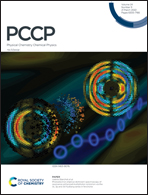Choline chloride and ethylene glycol based deep eutectic solvent (DES) versus hydroxyl functionalized room temperature ionic liquids (RTILs): assessing the differences in microscopic behaviour between the DES and RTILs†
Abstract
With the aim of understanding the differences in the behavior of deep eutectic solvents (DESs) and room temperature ionic liquids (RTILs) in terms of their structure, dynamics, and intra- and intermolecular interactions, three different ILs and one DES having similar functionalities (hydroxyl) have been investigated by using both ensembled average and single-molecule spectroscopic techniques. Specifically, for this purpose, a choline chloride based DES (ethaline) and three hydroxyl functionalized ILs (1-(2-hydroxyethyl)-3-imidazolium bis(trifluoromethanesulfonyl)imide ([OHEMIM][NTF2]), N-(2-hydroxyl ethyl)-N-methylpyrrolidinium bis(trifluoromethanesulfonyl)imide ([OHEMPy][NTf2]), and N-(2-hydroxyethyl)-N,N-dimethylpropan-1-aminium bis(trifluoromethanesulfonyl)imide ([OHC3CH][NTf2])) are employed and investigated by EPR, time-resolved fluorescence, NMR and FCS studies. Estimation of polarity through EPR spectroscopy has revealed that the hydroxyl ILs employed in these studies are hyper-polar (close to water) in nature, whereas the polarity of the DES is found to be close to those of aliphatic polyhydroxy-alcohols. Interestingly, both time-resolved fluorescence anisotropy and FCS studies on these systems have suggested that the hydroxyl ILs are more dynamically heterogeneous than the DES. More interestingly, PFG-NMR measurements have indicated that the fluid structure of ethaline is relatively more associated as compared to those of the ILs despite the fact that all the cations have the same hydroxyl functionalities. All these investigations have essentially demonstrated that, despite having similar functionalities, both the DES and hydroxyl ILs employed in the present study exhibit microscopic behaviours that are significantly different from each other, indicating the interplay of various intermolecular interactions within the constituent species in governing the behaviours of these solvent systems.



 Please wait while we load your content...
Please wait while we load your content...